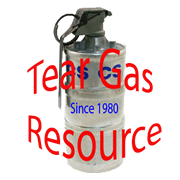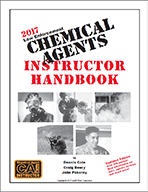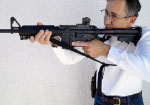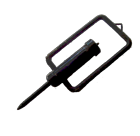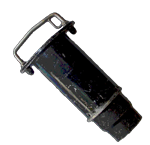To understand VP and PAVA, we first need to understand the makeup of Oleoresin Capsicum (OC) and pepperspray formulations. Oleoresin Capsicum is a blend (oleo) of oils (resins) taken from pepper (capsicum) plants. These oils are extracted, then dried and granulated for use in self-defense products. The oil is a blend of several different chemical compounds, each of which are called capsaicinoids.
A Capsaicinoid is the compound that causes a burning sensation and inflammation of the mucous membranes when applied on human beings. Each of the six major capsaicinoids in OC trigger a unique burning sensation. The capsaicinoids are: Capsaicin, Pelargonylvanillylamide, Dihydrocapsaicin, Nordihydrocapsaicin, Homodihydrocapsaicin, and Homocapsaicin.
Homocapsaicin.
Capsaicin and Pelargonylvanillylamide are the “hottest” of the capsaicinoids and are equal in “heat values”. The other capsaicinoids have significantly less heat value associated with them. Pelargonylvanillylamide, is also known as VP, Nonivamide, Capsaicin II, Synthetic Capsaicin, and PAVA. Capsaicin or Pelargonylvanillylamide is the compound that generates the spiciness in chili peppers and the burning sensation in pepper sprays.
References are often made to chemical sprays that contain 5 percent or 10 percent OC. In and of itself, that percentage doesn’t mean much when measuring the heat level of any particular spray. The effectiveness of any pepperspray is related to the amount of capsaicinoid in each burst, not the percentage within the canister.
Heat Level Test Methods
Another measure of effectiveness is the Scoville Heat Unit (SHU). The process by which SHU’s are calculated is known as the Scoville Organoleptic Test. In this test, participants taste a chili sample and subjectively record its heat level. Samples are then diluted until the taster can no longer detect heat; this dilution is called the Scoville Heat Unit. The hottest chili pepper today is: in dispute. Some people think the Carolina Reaper Pepper and others the Ghost Pepper.
The amount and type of capsaicinoid within an OC spray is calculated using the High Performance Liquid Chromatography (HPLC) method. The VP chemical compound is so similar to capsaicin that the standard HPLC test cannot distinguish it from capsaicin.
To differentiate Capsaicin from VP, a Gas Chromatograph Mass Spectrometer (GC-MS) test must be performed. A GC-MS test calculates the amount of compounds in parts-per-million (ppm). To get a quick conversion from HPLC to Scoville, multiply the ppm by 15 to get the Scoville Heat Unit.
Using the more sophisticated GC-MS test, scientists discovered VP compound in oleoresin capsicum. VP has one less carbon in its chemical structure than capsaicin. VP compound can be extracted from OC just like capsaicin can be extracted. VP is also present in plants other than peppers (such as vanilla beans) and can be extracted from those sources as well.
VP has earned the title of synthetic capsaicin because like Capsaicin, it can also be produced in a laboratory. It has also been named Capsaicin II because of its similarity to capsaicin. The EPA has recently given VP its own Chemical Abstracts Service (CAS) Registry Number 2444-46-4.
Typical OC aerosol sprays have 0.50% capsaicinoids and 0.18% capsaicin by weight. Again, the degree of heat is dependant upon the percentage of the six capsaicinoids within the canister.
Type |
% of Mixture |
Heat Level |
Relative Heat (% times Heat Level) |
Capsaicin |
0.18% |
100 |
18 |
VP |
0.01% |
100 |
1 |
Dihydrocapsaicin |
0.02% |
75 |
1.5 |
Nordihydrocapsaicin |
0.04% |
50 |
2 |
Homodihydrocapsaicin |
0.11% |
25 |
2.5 |
Homocapsaicin |
0.14% |
25 |
3.5 |
Total |
0.50% |
|
28.5 |
Heat Levels
The above chart shows the six types of capsaicinoids found in an OC mixture and the relationship between the average percentage of capsaicinoid within a mixture and its overall Relative Heat level.
In this example, the aerosol product would have a heat level of 28.5. From year to year (and from crop to crop) the heat levels of the capsaicin extracted from peppers can change dramatically. The amount of the compound mixture in the pepper varies based on the type of pepper, the climate it was grown in, and how healthy the plant was. If a mixture contained pure Capsaicin or VP, the relative heat level would be 100, or almost three and one-half times hotter than current OC concentrations.
Why don’t all manufacturers use VP or pure capsaicin in their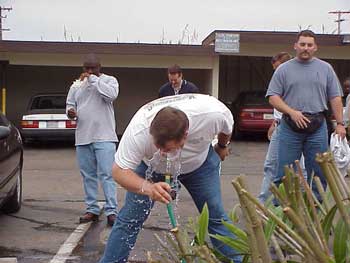 products? The simple answer is that VP is more expensive to produce. Until the cost of producing VP is lowered, the inconsistencies that occur in heat levels of OC products will continue. Some manufacturers keep the consistency of their heat levels by adding VP.
products? The simple answer is that VP is more expensive to produce. Until the cost of producing VP is lowered, the inconsistencies that occur in heat levels of OC products will continue. Some manufacturers keep the consistency of their heat levels by adding VP.
There have been no specific medical studies conducted using VP as a self-defense spray; however, VP shares the same chemical makeup as OC. Because it affects the human body exactly the same way, past studies conducted with OC can be extended to VP.
We know from extensive usage documentation by the California Department of Justice that the level of OC in today’s sprays will affect approximately 86% of the people that law enforcement officers contact. We have been living with this 14% failure rate for a long time. Will a new chemical that is three and a half times hotter affect a larger percentage of the population? Only time and usage statistics will tell the answer.
Glossary
| Term | Description |
Capsicum |
Common peppers |
Oleoresin Capsicum |
The extract of the dried ripe fruits of peppers. It contains a complex mixture of essential oils, waxes, dried, colored organic cellulose materials, and several capsaicinoids. |
Oleo=blend |
|
Resin=oil |
|
Capsicum=pepper |
|
Capsaicinoids |
The pungent components of peppers. They encompass at least 6 major compounds: Capsaicin, Dihydrocapsaicin, Nordihydrocapsaicin, Homodihydrocapsaicin, Homocapsaicin, and Pelargonylvanillylamide. |
Capsaicin |
A colorless, crystalline, bitter compound present in capsicum. The amount varies depending on the species and crop year of pepper. Heat level is equal to “VP”. Both are the hottest of the capsaicinoids. |
Capsaicin II |
Another term for “VP” |
Nonivamide |
Another term for “VP” |
Pelargonylvanillylamide (“VP”) |
Discovered in 1911, “VP” is a purified natural compound found in pepper plants. Is as hot as Capsaicin but can be extracted from other naturally occurring sources. |
PAVA |
Another term for “VP”. |
HPLC and GC-MS |
High Performance Liquid Chromatography and Gas Chromatograph Mass Spectrometry are two of the standard chemical analysis methods to scientifically determine the concentration of compounds such as Capsaicin and Pelargonylvanillylamide in chemical agent compounds and sprays. |
Scoville Heat Units (SHU) |
SHU testing is a “tongue” tasting to determine the heat level of the spice by a panel of 5 individuals. The test is not accurate since it depends on individual taste sensitivity that changes from person to person and does not measure the actual chemical percentage within the product. |
Synthetic Capsaicin |
Another term for “VP” |
CAS Registry Numbers
CAS Registry Numbers are often referred to as CAS RNs or CAS Numbers. These are unique identifiers for chemical substances. A Registry Number itself has no inherent chemical significance but it does provide a definitive way to identify a chemical substance or molecular structure when there are many possible systematic, generic, proprietary, or trivial names. CAS Registry Numbers are used in many other public and private databases as well as chemical inventory listings.
Medical reports about OC/PAVA use
Abstract: Cocaine-Induced Agitated Delirium, Forceful Struggle, and minor head injury: A Further Definition of Sudden Death During Restraint Anesthesiology 85-933, 1996
This study draws a link between a minor head wound producing dopamine and noreineprine and cocaine induced delirium. Alone none of which can cause death but taken together can cause cardiac arrest.
The Effects of Positional Restraint on Heart Rate and Oxygen Saturation The Journal of Emergency Medicine Vol 17, N0 5, pp777-782, 1999
Debunks the myth of positional asphyxia.
Pepper Spray: A Magic Bullet under Scrutiny. American Civil Liberties Union of Southern California Fall 1993
The ACLU wants restrictions on the use of OC spray and in investigation of in-custody deaths of persons who have been sprayed with OC.
Use of Force Policies and Training Recommendations: Based on the Medical Implications of Oleoresin Capsicum. Darrel Ross, Ph.D. PPCT director of research
Reviews some literature on possible OC injuries recommends agency review of use of force policies and encouraged trainers not to expose trainees to OC.
An Appraisal of the Technologies of Political Control. Omega Foundation Summary & Options Report, September 1998
A private non-profit looks at crowd control technologies including tear gas. Advocates the cessation of the use of Peppergas in Europe because the FBI agent took a kickback and the theory of positional asphyxia.
Nonlethal Weapons Technologies, Legalities, and potential Policies. Maj. Joseph Cook III.
Reviews nonlethal weapons including tear gas. Illustrates how tear gas fits into the Gas Protocol Treaty.
Pepper Spray and In-Custody Deaths. IACP Executive Brief March 1994
Summary of in-custody deaths where OC was used up to the writing of the article. Makes the recommendation that agencies should be wary of all arrestee's that fit certain criteria.
Less-than-Lethal Weapons: New Solutions for Law Enforcement. IACP Executive Brief December 1993
Summary of less than lethal rounds under development around the country including OC.
A Review of the Literature Regarding Oleoresin Capsicum. Charles Petty, MD December 1997
Dr. Petty's opinion that OC is safe for use with no serious side effects and hypothermia and cancer will not result from its use.
Restraint Position and Positional Asphyxia. General Clinical Investigation/original Contribution, Theodore Chan, MD, March 1997
Dr. Chan's study results debunking positional asphyxia.
Statement On The Use Of Pava (Nonivamide) As An Incapacitant Spray. UK Department of Health Committee on Toxicity, Cot/02/2 - April 2002
Examines the safety of PAVA for use as a self defense spray. Finds that it is generally safe for use.
